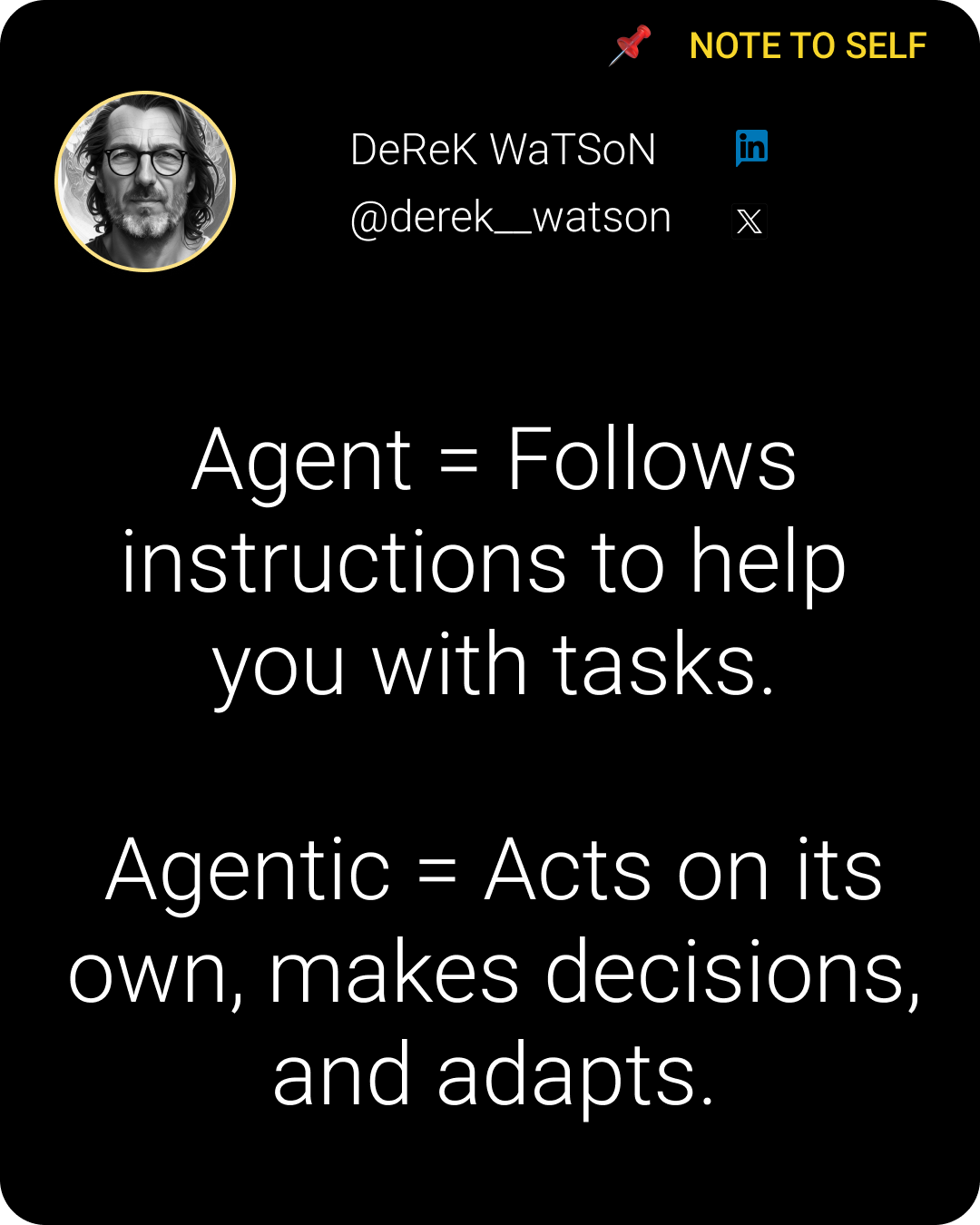Here’s your Monday dose of The AI Brief.
Your weekly dose of AI breakthroughs, startup playbooks, tool hacks and strategic nudges—empowering founders to lead in an AI world.
📈 Trending Now
The week’s unmissable AI headlines.
💡 Innovator Spotlight
Meet the change-makers.
🛠️ Tool of the Week
Your speed-boost in a nutshell.
📌 Note to Self
Words above my desk.
📈 Trending Now
🤖 ChatGPT Agent breeches Cloudflare’s ‘I Am Not a Robot’ test
→ OpenAI’s ChatGPT Agent autonomously clicked through Cloudflare’s ‘I Am Not a Robot’ checkbox by mimicking human mouse movements and narrating its actions in real time.
→ The incident went viral on Reddit and Hacker News within hours, sparking urgent debates about AI’s ability to bypass CAPTCHAs.→ Experts warn that checkbox CAPTCHAs are now obsolete, likely driving adoption of behavioural biometrics and continuous authentication models.
→ Founders: Incorporate human-in-the-loop verification and multi-factor authentication into autonomous AI workflows to guard against unseen security bypasses.
💣 AI LLMs independently plan and execute cyberattacks in lab study
→ A Carnegie Mellon–Anthropic study showed LLMs can autonomously plan and execute multi-stage cyberattacks—replicating tactics from the 2017 Equifax breach—by structuring hierarchical agent systems.
→ Sub-agents handled reconnaissance, exploit deployment and data exfiltration, adapting strategies in real time without human input.
→ Founders: Embed AI-driven red-teaming into your security QA to uncover and mitigate hidden threat vectors before adversaries exploit them.
⚖️ Google agrees to sign EU’s AI Code of Practice
→ Google confirmed it will sign the EU’s voluntary General-Purpose AI Code of Practice, committing to safety, transparency and data-governance standards.
→ Kent Walker noted some copyright and trade-secret provisions could slow approvals and dampen Europe’s AI competitiveness.
→ Founders: Align your product roadmaps with emerging regulatory frameworks to leverage safe innovation and avoid compliance bottlenecks.
🤝 Anthropic cuts off OpenAI’s access to Claude models
→ On 1 August 2025, Anthropic revoked OpenAI’s API access to its Claude models, alleging OpenAI misused Claude Code for benchmarking GPT-5, in breach of service terms.
→ WIRED reports Anthropic defended the move as necessary to protect its IP, while OpenAI maintains benchmarking is standard practice for safety evaluations.
→ Founders: Specify permissible benchmarking and reverse-engineering terms in your API contracts to prevent disruptive service cuts.
🎥 Disney shelves AI deepfake of Dwayne Johnson in ‘Moana’
→ Disney scrapped plans to use AI deepfakes of Dwayne Johnson in its live-action ‘Moana’ after 18 months of legal and ethical review, citing IP control and union concerns.
→ The decision underscores industry tensions as studios weigh AI workflows against brand trust and contractual obligations.
→ Founders: Balance AI-driven content innovations with IP rights, labour relations and brand reputation before high-profile deployments.
🌏 Nvidia orders 300,000 H20 AI chips from TSMC amid China demand
→ Nvidia placed a 300,000-unit order for its China-compliant H20 GPUs with TSMC after U.S. export curbs eased, aiming to meet surging Chinese cloud demand.
→ The H20, built under reduced-compute constraints, now powers inference workloads across hyperscalers and enterprise data centres.
→ Founders: Architect hardware-agnostic systems and negotiate performance-based supply agreements to navigate geopolitical chip volatility.
🎬 Amazon backs ‘Showrunner’, the Netflix of AI for TV content creation
→ Amazon invested in Fable Studio’s Showrunner, dubbed the “Netflix of AI,” enabling users to generate or remix TV show scenes via text prompts, shifting from free preview to a $10–$20 monthly subscription.
→ Coverage in Variety and Forbes highlights IP-licensing and environmental-impact concerns, even as studios like Disney explore limited partnerships.
→ Founders: Explore strategic alliances with generative AI platforms to disrupt content pipelines and harness user-generated creativity.
💡Innovator Spotlight
Amazon-backed Skild AI launches Skild Brain: general-purpose model for multi-purpose robots
👉 Who they are:
– Skild AI, a robotics startup building a shared learning brain for all robot types.
👉 What’s unique:
– On 29 July 2025, Skild AI unveiled Skild Brain, a single AI model that powers industrial arms, humanoids and mobile robots alike, trained on simulated scenarios and live video feedback.
– It combines human action videos and real-world deployment data with physics-based simulations to teach robots to climb stairs, adapt to unexpected pushes and handle cluttered environments.
– This defies the norm of task-specific robot controllers and fractures the assumption that diverse robots need bespoke AI, instead enabling a unified brain that improves as every device learns.
– The approach slashes development time, allowing new robot functions to roll out across the entire fleet simultaneously.
– Skild’s partnerships with LG CNS and logistics firms prove this shared-brain model can scale in real factories.
👉 Pinch-this lesson:
– Prototype a unified AI component that can learn from diverse real-world feedback rather than building isolated models for each use case.
🛠️ Tools of the Week
1. NVIDIA Isaac Lab
What it does: Provides a lightweight sample application built on Isaac Sim for robot learning and foundation model training.
Why founders should care: It lets you prototype and validate new robot foundation models in photorealistic simulations without heavy on-prem hardware.
Quick start tip: Clone the Isaac Lab repo from NVIDIA’s GitHub and follow the README to launch sample scenarios.
—————————————————————————
2. Ignition Gazebo
What it does: Introduces Gazebo Ignition’s July release with closed-loop manipulator simulations and feature freeze for Jetty, enhancing real-time control capabilities.
Why founders should care: You can test advanced robotic manipulator algorithms in a high-fidelity simulated environment before physical deployment.
Quick start tip: Install the latest ros_gz packages for your ROS2 distro and launch the closed-loop manipulator tutorial.
—————————————————————————
3. Genesis AI Simulation Stack
What it does: Generates synthetic multimodal data at scale to train universal robotics foundation models.
Why founders should care: It unifies data pipelines and synthetic environments, reducing time to build and fine-tune general-purpose robot brains.
Quick start tip: Sign up for Genesis AI’s beta, connect your simulation assets via their API, and start generating training data.
—————————————————————————
4. DeepFleet
What it does: Coordinates warehouse robot routes using a generative AI model to improve fleet efficiency by up to 10%.
Why founders should care: It shows how generative AI can optimise complex robotic fleets and boost throughput immediately.
Quick start tip: Launch DeepFleet via AWS SageMaker and run the provided example notebooks on your warehouse map data.
—————————————————————————
5. Multi-Sensor Fusion Framework
What it does: Fuses UWB, wheel odometry and AHRS data via a Kalman filter for reliable indoor robot localisation.
Why founders should care: It improves localisation accuracy in cluttered environments without extra expensive sensors.
Quick start tip: Clone the GitHub repo linked in the paper and run pip install -r requirements.txt to try it out.
—————————————————————————
6. Ambi Robotics PRIME-1
What it does: Offers PRIME-1, a production-ready industrial manipulation foundation model trained on 20 million real images for 3D perception and picking.
Why founders should care: It accelerates development and reliability of 3D perception and pick-and-place solutions with real-world data.
Quick start tip: Request API access from Ambi Robotics and test PRIME-1 on your own pick-and-place datasets.
—————————————————————————
7. Roboflow for Startups Program
What it does: Grants free access to advanced vision features like RF-DETR model sizes and semantic segmentation tools for startups.
Why founders should care: You can iterate and deploy vision-driven robotic applications at minimal cost.
Quick start tip: Apply to the Roboflow for Startups programme to unlock premium computer-vision pipelines.
—————————————————————————
8. Ambiq SoC on Edge Impulse
What it does: Adds support for Ambiq’s Apollo3 SoC in Edge Impulse for on-device AI inference on low-power microcontrollers.
Why founders should care: It lets you run lightweight robotics inference directly on microcontroller-class hardware, reducing latency and power draw.
Quick start tip: Select the Ambiq target in Edge Impulse, compile your model, and flash it to your Apollo3 board.
—————————————————————————
9. ABB OmniCore
What it does: Delivers a unified robotics and PLC control platform for industrial and collaborative robots under one SDK.
Why founders should care: It simplifies multi-robot coordination and custom control logic in a single development environment.
Quick start tip: Download the OmniCore SDK from ABB, install the runtime, and connect to a demo robot via Ethernet.
—————————————————————————
10. NVIDIA Isaac GR00T N1.5
What it does: Introduces Isaac GR00T N1.5, an open foundation model for humanoid robot reasoning with enhanced dexterity primitives.
Why founders should care: It serves as a versatile “brain” for humanoid research, cutting development cycles for complex motion tasks.
Quick start tip: Pull the GR00T N1.5 Docker image and integrate it into your ROS2 workspace to drive your humanoid simulator.
📌 Note to Self
Thank you for reading. If you liked it, share it with your friends, colleagues and everyone interested in the startup Investor ecosystem.
If you've got suggestions, an article, research, your tech stack, or a job listing you want featured, just let me know! I'm keen to include it in the upcoming edition.
Please let me know what you think of it, love a feedback loop 🙏🏼
🛑 Get a different job.
Subscribe below and follow me on LinkedIn or Twitter to never miss an update.
For the ❤️ of startups
✌🏼 & 💙
Derek






